1999 SUBARU LEGACY engine
[x] Cancel search: enginePage 915 of 1456
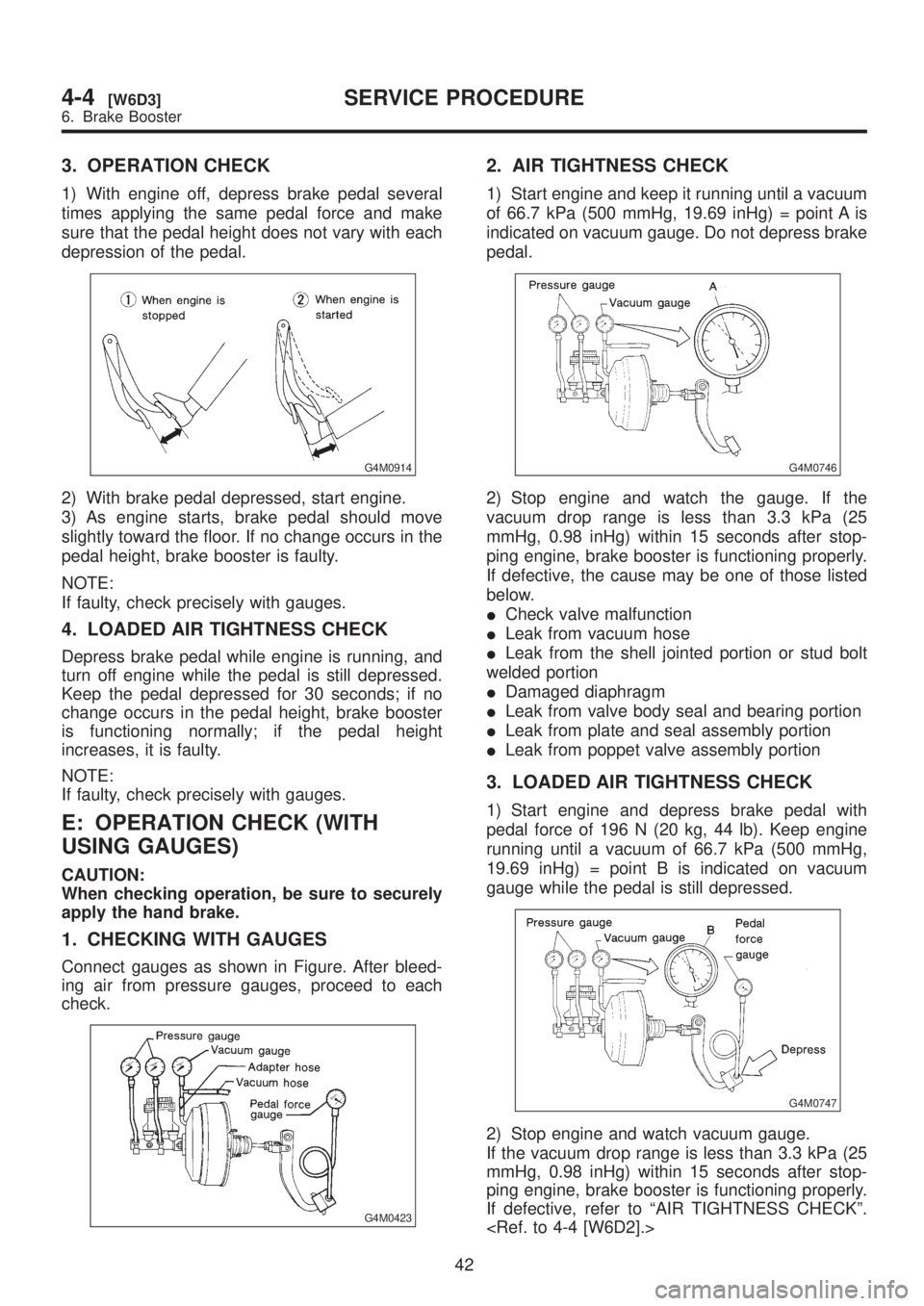
3. OPERATION CHECK
1) With engine off, depress brake pedal several
times applying the same pedal force and make
sure that the pedal height does not vary with each
depression of the pedal.
G4M0914
2) With brake pedal depressed, start engine.
3) As engine starts, brake pedal should move
slightly toward the floor. If no change occurs in the
pedal height, brake booster is faulty.
NOTE:
If faulty, check precisely with gauges.
4. LOADED AIR TIGHTNESS CHECK
Depress brake pedal while engine is running, and
turn off engine while the pedal is still depressed.
Keep the pedal depressed for 30 seconds; if no
change occurs in the pedal height, brake booster
is functioning normally; if the pedal height
increases, it is faulty.
NOTE:
If faulty, check precisely with gauges.
E: OPERATION CHECK (WITH
USING GAUGES)
CAUTION:
When checking operation, be sure to securely
apply the hand brake.
1. CHECKING WITH GAUGES
Connect gauges as shown in Figure. After bleed-
ing air from pressure gauges, proceed to each
check.
G4M0423
2. AIR TIGHTNESS CHECK
1) Start engine and keep it running until a vacuum
of 66.7 kPa (500 mmHg, 19.69 inHg) = point A is
indicated on vacuum gauge. Do not depress brake
pedal.
G4M0746
2) Stop engine and watch the gauge. If the
vacuum drop range is less than 3.3 kPa (25
mmHg, 0.98 inHg) within 15 seconds after stop-
ping engine, brake booster is functioning properly.
If defective, the cause may be one of those listed
below.
ICheck valve malfunction
ILeak from vacuum hose
ILeak from the shell jointed portion or stud bolt
welded portion
IDamaged diaphragm
ILeak from valve body seal and bearing portion
ILeak from plate and seal assembly portion
ILeak from poppet valve assembly portion
3. LOADED AIR TIGHTNESS CHECK
1) Start engine and depress brake pedal with
pedal force of 196 N (20 kg, 44 lb). Keep engine
running until a vacuum of 66.7 kPa (500 mmHg,
19.69 inHg) = point B is indicated on vacuum
gauge while the pedal is still depressed.
G4M0747
2) Stop engine and watch vacuum gauge.
If the vacuum drop range is less than 3.3 kPa (25
mmHg, 0.98 inHg) within 15 seconds after stop-
ping engine, brake booster is functioning properly.
If defective, refer to ªAIR TIGHTNESS CHECKº.
42
4-4[W6D3]SERVICE PROCEDURE
6. Brake Booster
Page 916 of 1456

4. LACK OF BOOSTING ACTION CHECK
Turn off engine, and set the vacuum gauge read-
ing at ª0º. Then, check the fluid pressure when
brake pedal is depressed. The pressure must be
greater than the standard value listed below.
Brake pedal force147N (15 kg,
33 lb)294N (30kg, 66
lb)
Models without ABS785 kPa (8
kg/cm
2,114
psi)2,158 kPa (22
kg/cm2, 313 psi)
Models with ABS588 kPa (6
kg/cm
2, 85 psi)1,667 kPa (17
kg/cm2, 242 psi)
5. BOOSTING ACTION CHECK
Set the vacuum gauge reading at 66.7 kPa (500
mmHg, 19.69 inHg) by running engine. Then,
check the fluid pressure when brake pedal is
depressed. The pressure must be greater than the
standard value listed below.
Brake pedal force147N (15 kg,
33 lb)294N (30kg, 66
lb)
Models without ABS5,492 kPa (56
kg/cm
2, 796
psi)8,434 kPa (86
kg/cm2, 1,223 psi)
Models with ABS5,394 kPa (55
kg/cm
2,782 psi)10,003 kPa (102
kg/cm2, 1,450 psi)
7. Brake Hose
A: REMOVAL
1) Separate brake pipe from brake hose.
(Always use flare nut wrench and be careful not to
deform flare nut.)
G4M0426
2) Pull out clamp to remove brake hose.
3) Remove clamp at strut and union bolt.
B: INSTALLATION
1. FRONT BRAKE HOSE
1) Route end of brake hose (on caliper side)
through hole in brake hose bracket at strut loca-
tion.
2) Tighten end of brake hose at caliper using a
union bolt.
Tightening torque (Union bolt):
18
±3 N´m (1.8±0.3 kg-m, 13.0±2.2 ft-lb)
G4M0427
3) Secure middle fitting of brake hose to bracket at
strut location using a clamp.
4) Position disc in straight-forward direction and
route brake hose through hole in bracket on wheel
apron side.
CAUTION:
Be sure brake hose is not twisted.
5) Temporarily tighten flare nut to connect brake
pipe and hose.
6) Fix brake hose with clamp at wheel apron
bracket.
43
[W7B1]4-4SERVICE PROCEDURE
7. Brake Hose
Page 917 of 1456
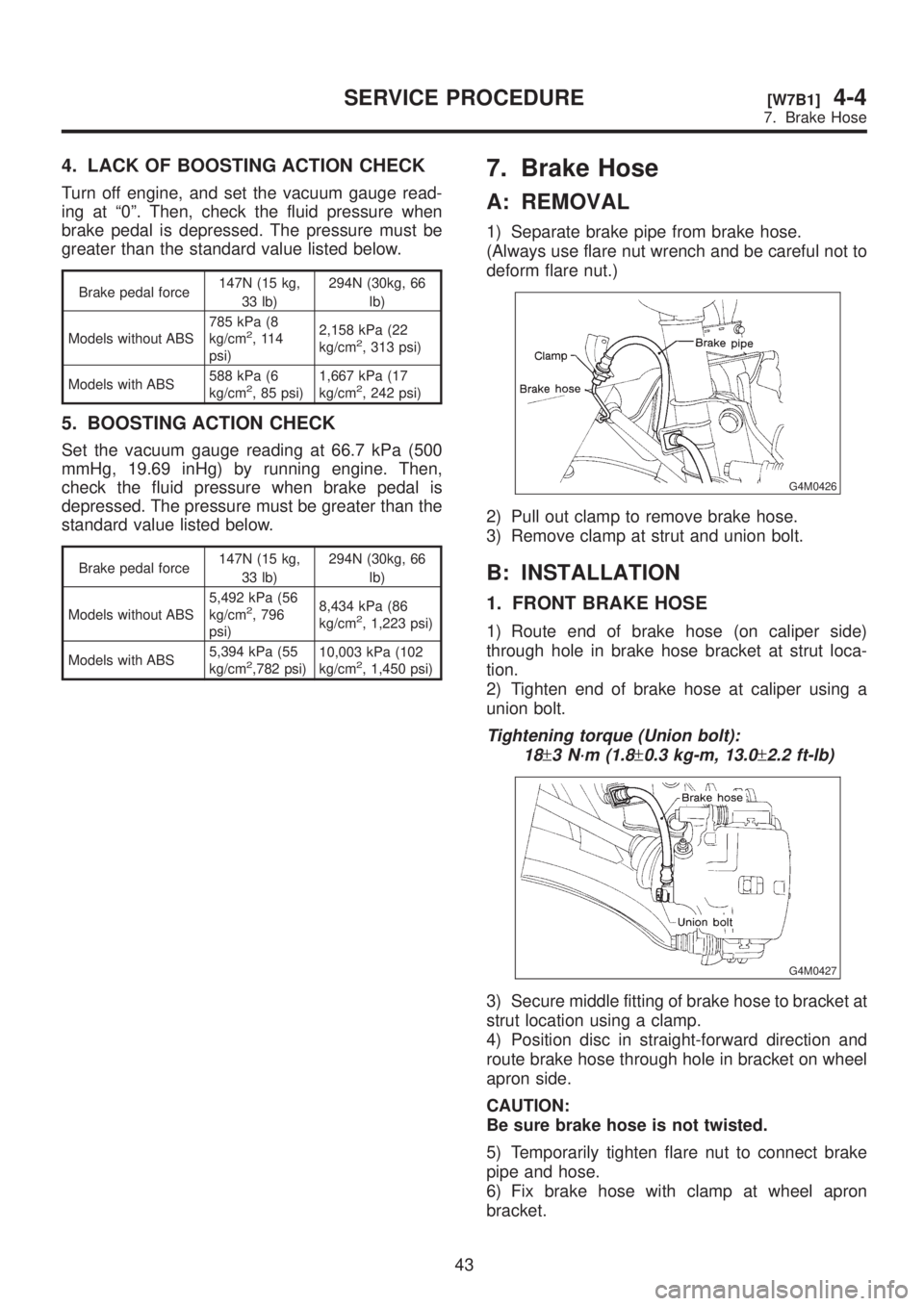
4. LACK OF BOOSTING ACTION CHECK
Turn off engine, and set the vacuum gauge read-
ing at ª0º. Then, check the fluid pressure when
brake pedal is depressed. The pressure must be
greater than the standard value listed below.
Brake pedal force147N (15 kg,
33 lb)294N (30kg, 66
lb)
Models without ABS785 kPa (8
kg/cm
2,114
psi)2,158 kPa (22
kg/cm2, 313 psi)
Models with ABS588 kPa (6
kg/cm
2, 85 psi)1,667 kPa (17
kg/cm2, 242 psi)
5. BOOSTING ACTION CHECK
Set the vacuum gauge reading at 66.7 kPa (500
mmHg, 19.69 inHg) by running engine. Then,
check the fluid pressure when brake pedal is
depressed. The pressure must be greater than the
standard value listed below.
Brake pedal force147N (15 kg,
33 lb)294N (30kg, 66
lb)
Models without ABS5,492 kPa (56
kg/cm
2, 796
psi)8,434 kPa (86
kg/cm2, 1,223 psi)
Models with ABS5,394 kPa (55
kg/cm
2,782 psi)10,003 kPa (102
kg/cm2, 1,450 psi)
7. Brake Hose
A: REMOVAL
1) Separate brake pipe from brake hose.
(Always use flare nut wrench and be careful not to
deform flare nut.)
G4M0426
2) Pull out clamp to remove brake hose.
3) Remove clamp at strut and union bolt.
B: INSTALLATION
1. FRONT BRAKE HOSE
1) Route end of brake hose (on caliper side)
through hole in brake hose bracket at strut loca-
tion.
2) Tighten end of brake hose at caliper using a
union bolt.
Tightening torque (Union bolt):
18
±3 N´m (1.8±0.3 kg-m, 13.0±2.2 ft-lb)
G4M0427
3) Secure middle fitting of brake hose to bracket at
strut location using a clamp.
4) Position disc in straight-forward direction and
route brake hose through hole in bracket on wheel
apron side.
CAUTION:
Be sure brake hose is not twisted.
5) Temporarily tighten flare nut to connect brake
pipe and hose.
6) Fix brake hose with clamp at wheel apron
bracket.
43
[W7B1]4-4SERVICE PROCEDURE
7. Brake Hose
Page 918 of 1456
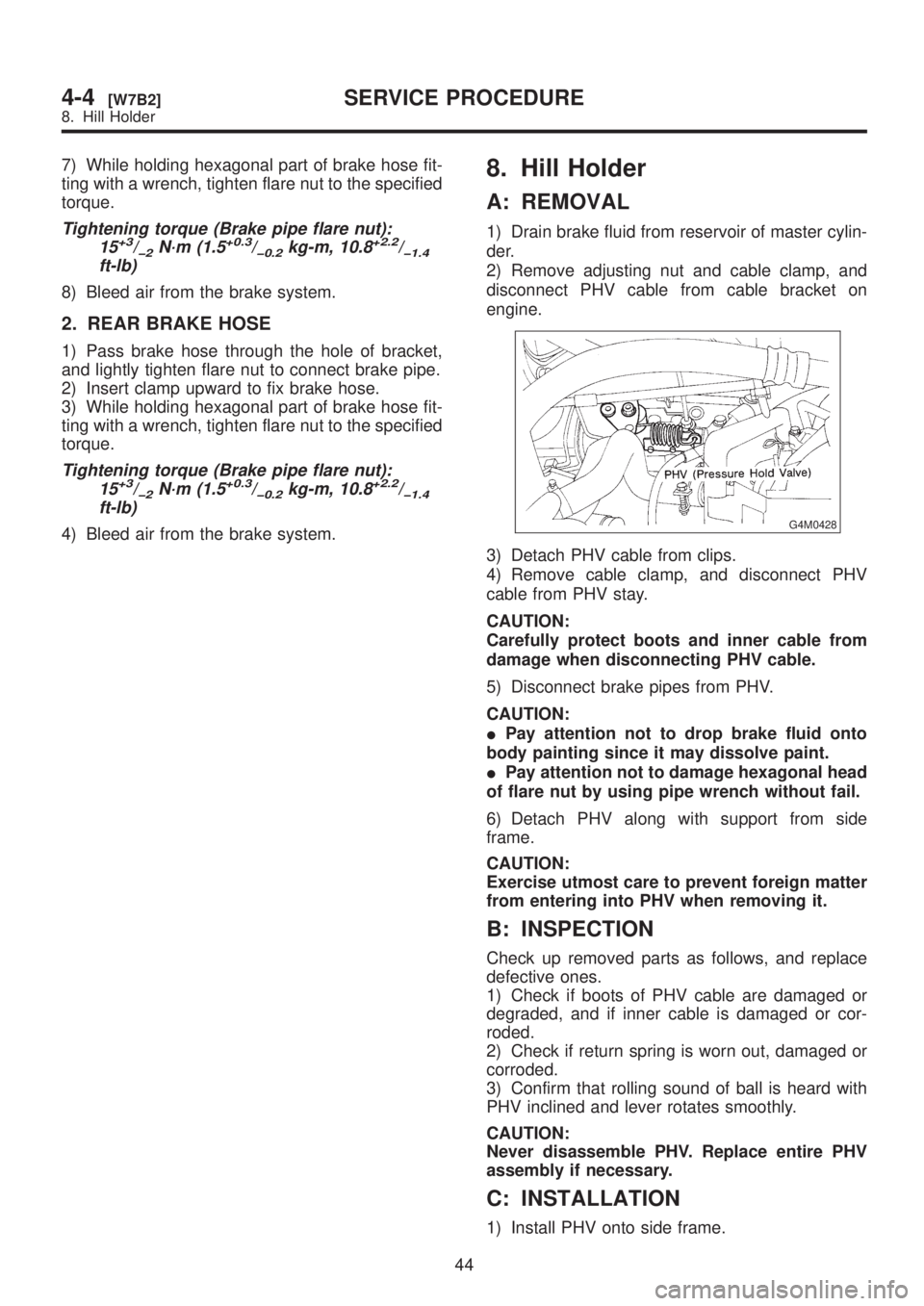
7) While holding hexagonal part of brake hose fit-
ting with a wrench, tighten flare nut to the specified
torque.
Tightening torque (Brake pipe flare nut):
15+3/þ2N´m (1.5+0.3/þ0.2kg-m, 10.8+2.2/þ1.4ft-lb)
8) Bleed air from the brake system.
2. REAR BRAKE HOSE
1) Pass brake hose through the hole of bracket,
and lightly tighten flare nut to connect brake pipe.
2) Insert clamp upward to fix brake hose.
3) While holding hexagonal part of brake hose fit-
ting with a wrench, tighten flare nut to the specified
torque.
Tightening torque (Brake pipe flare nut):
15+3/þ2N´m (1.5+0.3/þ0.2kg-m, 10.8+2.2/þ1.4ft-lb)
4) Bleed air from the brake system.
8. Hill Holder
A: REMOVAL
1) Drain brake fluid from reservoir of master cylin-
der.
2) Remove adjusting nut and cable clamp, and
disconnect PHV cable from cable bracket on
engine.
G4M0428
3) Detach PHV cable from clips.
4) Remove cable clamp, and disconnect PHV
cable from PHV stay.
CAUTION:
Carefully protect boots and inner cable from
damage when disconnecting PHV cable.
5) Disconnect brake pipes from PHV.
CAUTION:
IPay attention not to drop brake fluid onto
body painting since it may dissolve paint.
IPay attention not to damage hexagonal head
of flare nut by using pipe wrench without fail.
6) Detach PHV along with support from side
frame.
CAUTION:
Exercise utmost care to prevent foreign matter
from entering into PHV when removing it.
B: INSPECTION
Check up removed parts as follows, and replace
defective ones.
1) Check if boots of PHV cable are damaged or
degraded, and if inner cable is damaged or cor-
roded.
2) Check if return spring is worn out, damaged or
corroded.
3) Confirm that rolling sound of ball is heard with
PHV inclined and lever rotates smoothly.
CAUTION:
Never disassemble PHV. Replace entire PHV
assembly if necessary.
C: INSTALLATION
1) Install PHV onto side frame.
44
4-4[W7B2]SERVICE PROCEDURE
8. Hill Holder
Page 919 of 1456
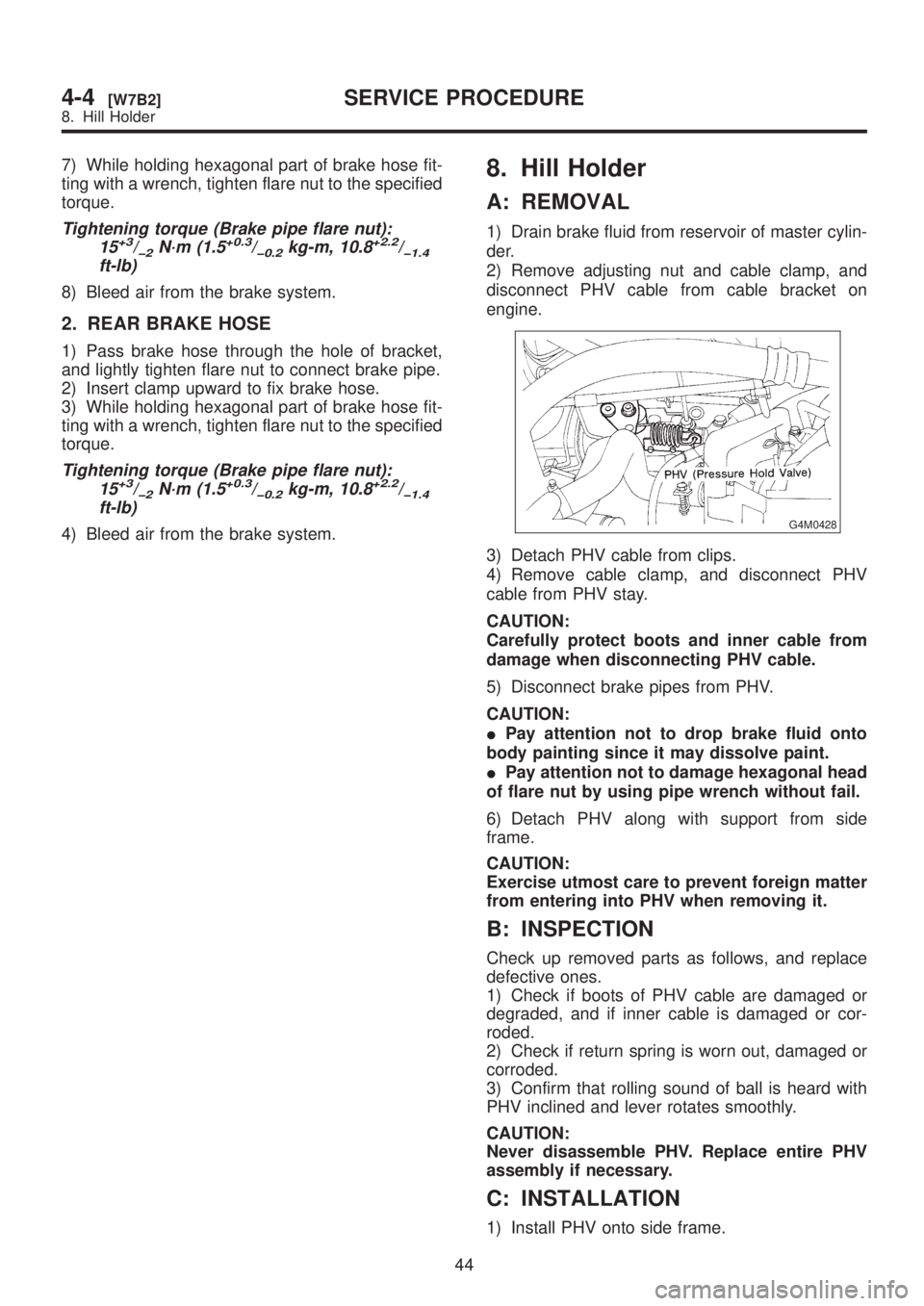
7) While holding hexagonal part of brake hose fit-
ting with a wrench, tighten flare nut to the specified
torque.
Tightening torque (Brake pipe flare nut):
15+3/þ2N´m (1.5+0.3/þ0.2kg-m, 10.8+2.2/þ1.4ft-lb)
8) Bleed air from the brake system.
2. REAR BRAKE HOSE
1) Pass brake hose through the hole of bracket,
and lightly tighten flare nut to connect brake pipe.
2) Insert clamp upward to fix brake hose.
3) While holding hexagonal part of brake hose fit-
ting with a wrench, tighten flare nut to the specified
torque.
Tightening torque (Brake pipe flare nut):
15+3/þ2N´m (1.5+0.3/þ0.2kg-m, 10.8+2.2/þ1.4ft-lb)
4) Bleed air from the brake system.
8. Hill Holder
A: REMOVAL
1) Drain brake fluid from reservoir of master cylin-
der.
2) Remove adjusting nut and cable clamp, and
disconnect PHV cable from cable bracket on
engine.
G4M0428
3) Detach PHV cable from clips.
4) Remove cable clamp, and disconnect PHV
cable from PHV stay.
CAUTION:
Carefully protect boots and inner cable from
damage when disconnecting PHV cable.
5) Disconnect brake pipes from PHV.
CAUTION:
IPay attention not to drop brake fluid onto
body painting since it may dissolve paint.
IPay attention not to damage hexagonal head
of flare nut by using pipe wrench without fail.
6) Detach PHV along with support from side
frame.
CAUTION:
Exercise utmost care to prevent foreign matter
from entering into PHV when removing it.
B: INSPECTION
Check up removed parts as follows, and replace
defective ones.
1) Check if boots of PHV cable are damaged or
degraded, and if inner cable is damaged or cor-
roded.
2) Check if return spring is worn out, damaged or
corroded.
3) Confirm that rolling sound of ball is heard with
PHV inclined and lever rotates smoothly.
CAUTION:
Never disassemble PHV. Replace entire PHV
assembly if necessary.
C: INSTALLATION
1) Install PHV onto side frame.
44
4-4[W7B2]SERVICE PROCEDURE
8. Hill Holder
Page 920 of 1456
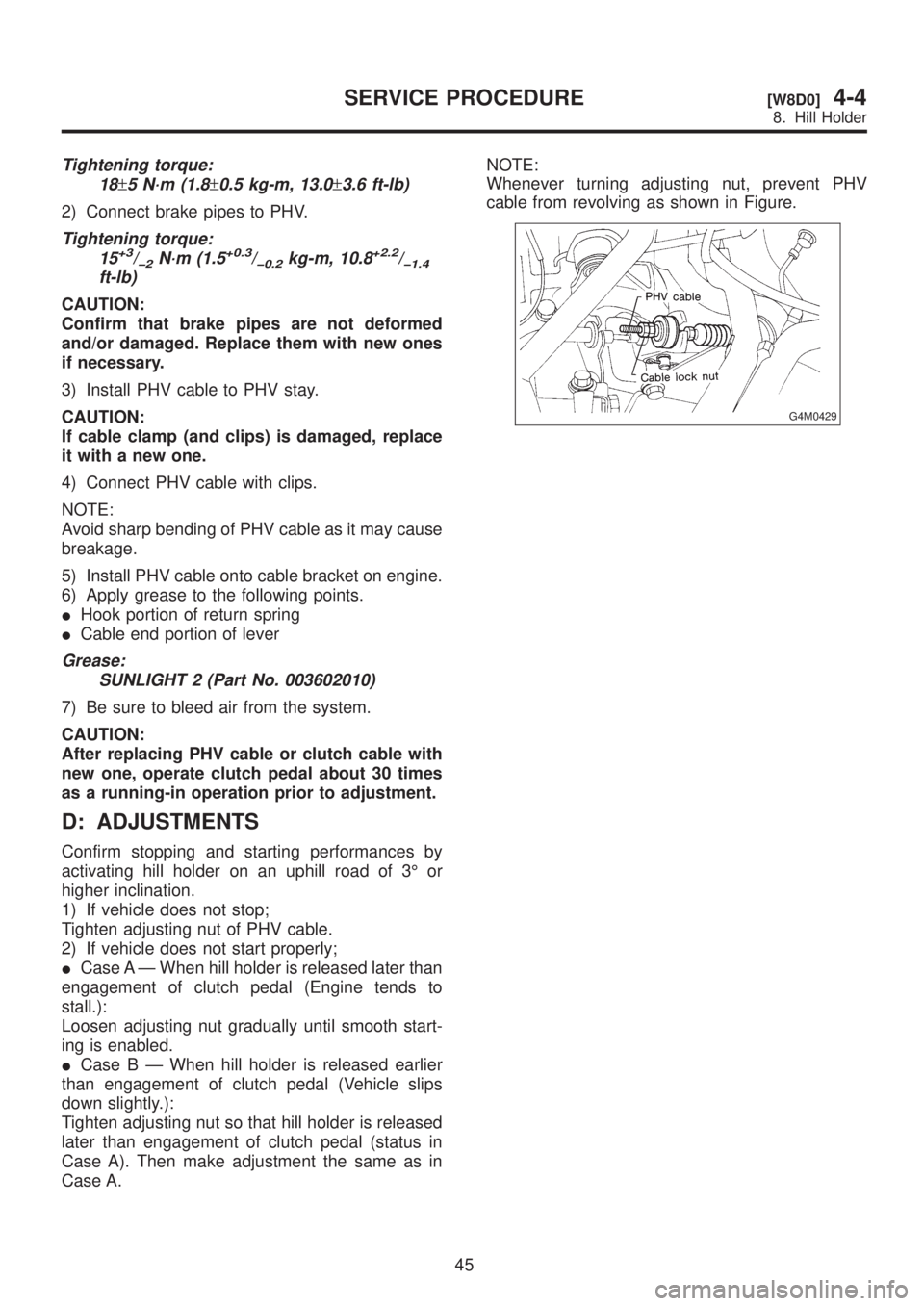
Tightening torque:
18
±5 N´m (1.8±0.5 kg-m, 13.0±3.6 ft-lb)
2) Connect brake pipes to PHV.
Tightening torque:
15+3/þ2N´m (1.5+0.3/þ0.2kg-m, 10.8+2.2/þ1.4ft-lb)
CAUTION:
Confirm that brake pipes are not deformed
and/or damaged. Replace them with new ones
if necessary.
3) Install PHV cable to PHV stay.
CAUTION:
If cable clamp (and clips) is damaged, replace
it with a new one.
4) Connect PHV cable with clips.
NOTE:
Avoid sharp bending of PHV cable as it may cause
breakage.
5) Install PHV cable onto cable bracket on engine.
6) Apply grease to the following points.
IHook portion of return spring
ICable end portion of lever
Grease:
SUNLIGHT 2 (Part No. 003602010)
7) Be sure to bleed air from the system.
CAUTION:
After replacing PHV cable or clutch cable with
new one, operate clutch pedal about 30 times
as a running-in operation prior to adjustment.
D: ADJUSTMENTS
Confirm stopping and starting performances by
activating hill holder on an uphill road of 3É or
higher inclination.
1) If vehicle does not stop;
Tighten adjusting nut of PHV cable.
2) If vehicle does not start properly;
ICase A Ð When hill holder is released later than
engagement of clutch pedal (Engine tends to
stall.):
Loosen adjusting nut gradually until smooth start-
ing is enabled.
ICase B Ð When hill holder is released earlier
than engagement of clutch pedal (Vehicle slips
down slightly.):
Tighten adjusting nut so that hill holder is released
later than engagement of clutch pedal (status in
Case A). Then make adjustment the same as in
Case A.NOTE:
Whenever turning adjusting nut, prevent PHV
cable from revolving as shown in Figure.
G4M0429
45
[W8D0]4-4SERVICE PROCEDURE
8. Hill Holder
Page 925 of 1456
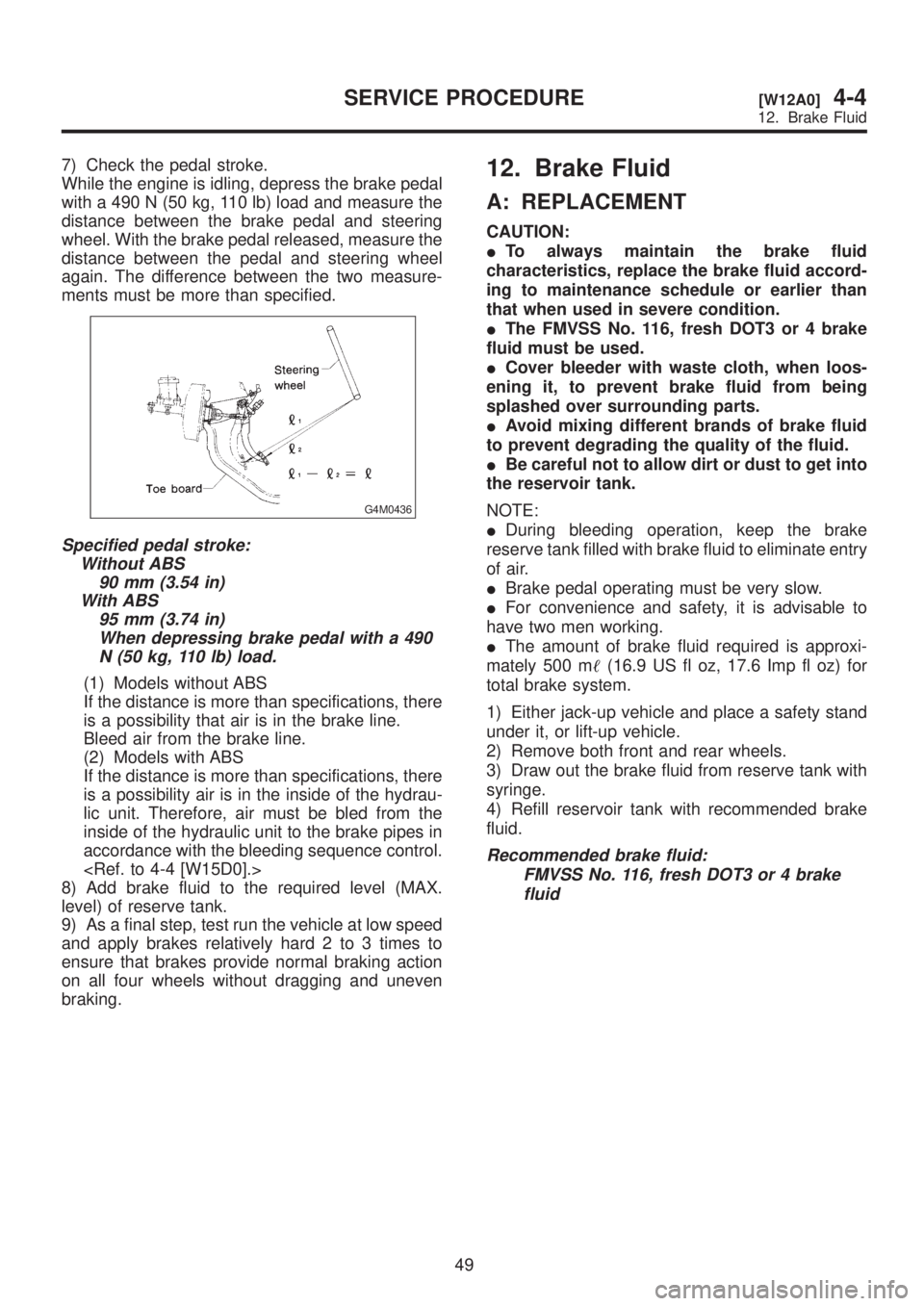
7) Check the pedal stroke.
While the engine is idling, depress the brake pedal
with a 490 N (50 kg, 110 lb) load and measure the
distance between the brake pedal and steering
wheel. With the brake pedal released, measure the
distance between the pedal and steering wheel
again. The difference between the two measure-
ments must be more than specified.
G4M0436
Specified pedal stroke:
Without ABS
90 mm (3.54 in)
With ABS
95 mm (3.74 in)
When depressing brake pedal with a 490
N (50 kg, 110 lb) load.
(1) Models without ABS
If the distance is more than specifications, there
is a possibility that air is in the brake line.
Bleed air from the brake line.
(2) Models with ABS
If the distance is more than specifications, there
is a possibility air is in the inside of the hydrau-
lic unit. Therefore, air must be bled from the
inside of the hydraulic unit to the brake pipes in
accordance with the bleeding sequence control.
8) Add brake fluid to the required level (MAX.
level) of reserve tank.
9) As a final step, test run the vehicle at low speed
and apply brakes relatively hard 2 to 3 times to
ensure that brakes provide normal braking action
on all four wheels without dragging and uneven
braking.
12. Brake Fluid
A: REPLACEMENT
CAUTION:
ITo always maintain the brake fluid
characteristics, replace the brake fluid accord-
ing to maintenance schedule or earlier than
that when used in severe condition.
IThe FMVSS No. 116, fresh DOT3 or 4 brake
fluid must be used.
ICover bleeder with waste cloth, when loos-
ening it, to prevent brake fluid from being
splashed over surrounding parts.
IAvoid mixing different brands of brake fluid
to prevent degrading the quality of the fluid.
IBe careful not to allow dirt or dust to get into
the reservoir tank.
NOTE:
IDuring bleeding operation, keep the brake
reserve tank filled with brake fluid to eliminate entry
of air.
IBrake pedal operating must be very slow.
IFor convenience and safety, it is advisable to
have two men working.
IThe amount of brake fluid required is approxi-
mately 500 m(16.9 US fl oz, 17.6 Imp fl oz) for
total brake system.
1) Either jack-up vehicle and place a safety stand
under it, or lift-up vehicle.
2) Remove both front and rear wheels.
3) Draw out the brake fluid from reserve tank with
syringe.
4) Refill reservoir tank with recommended brake
fluid.
Recommended brake fluid:
FMVSS No. 116, fresh DOT3 or 4 brake
fluid
49
[W12A0]4-4SERVICE PROCEDURE
12. Brake Fluid
Page 926 of 1456
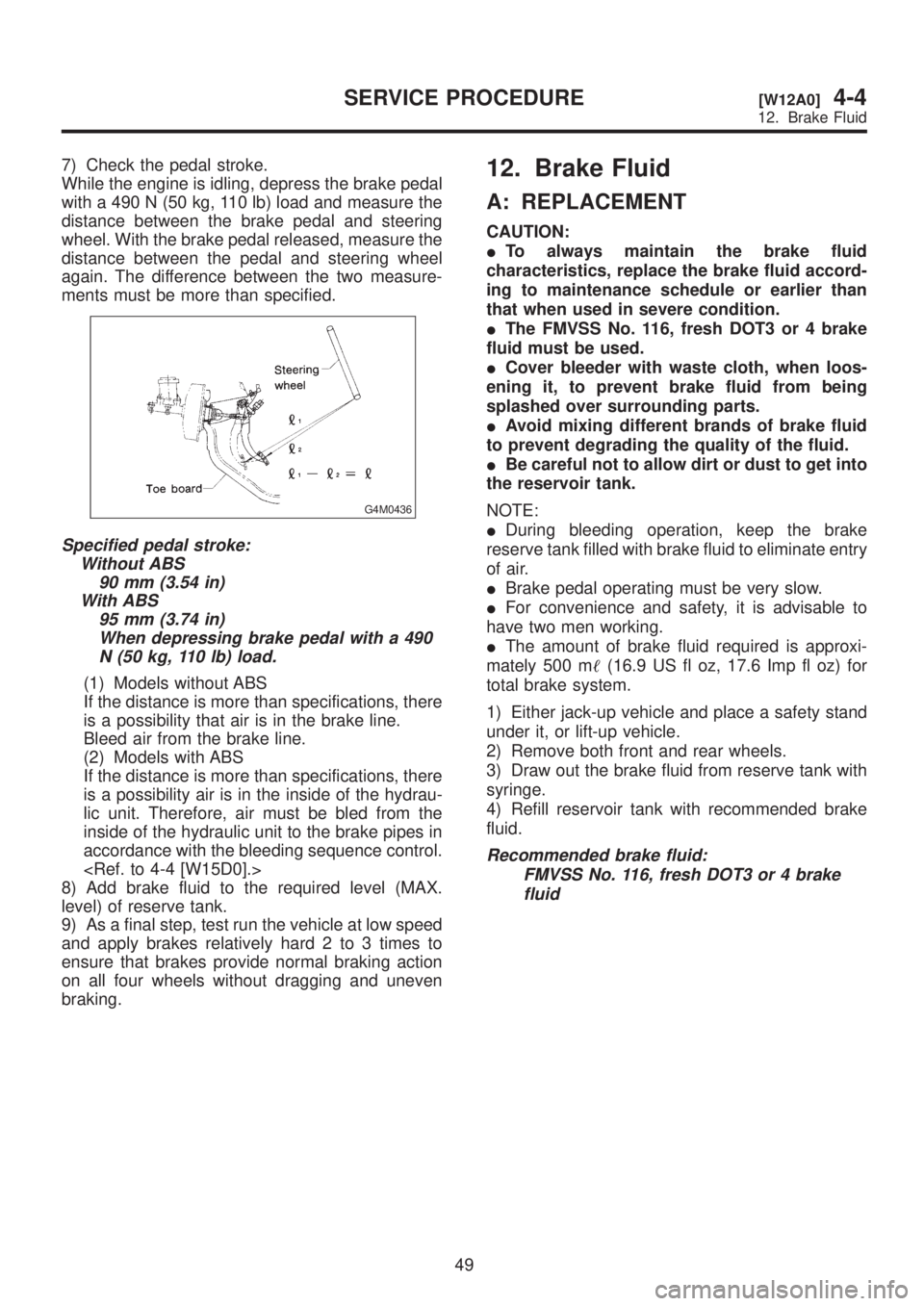
7) Check the pedal stroke.
While the engine is idling, depress the brake pedal
with a 490 N (50 kg, 110 lb) load and measure the
distance between the brake pedal and steering
wheel. With the brake pedal released, measure the
distance between the pedal and steering wheel
again. The difference between the two measure-
ments must be more than specified.
G4M0436
Specified pedal stroke:
Without ABS
90 mm (3.54 in)
With ABS
95 mm (3.74 in)
When depressing brake pedal with a 490
N (50 kg, 110 lb) load.
(1) Models without ABS
If the distance is more than specifications, there
is a possibility that air is in the brake line.
Bleed air from the brake line.
(2) Models with ABS
If the distance is more than specifications, there
is a possibility air is in the inside of the hydrau-
lic unit. Therefore, air must be bled from the
inside of the hydraulic unit to the brake pipes in
accordance with the bleeding sequence control.
8) Add brake fluid to the required level (MAX.
level) of reserve tank.
9) As a final step, test run the vehicle at low speed
and apply brakes relatively hard 2 to 3 times to
ensure that brakes provide normal braking action
on all four wheels without dragging and uneven
braking.
12. Brake Fluid
A: REPLACEMENT
CAUTION:
ITo always maintain the brake fluid
characteristics, replace the brake fluid accord-
ing to maintenance schedule or earlier than
that when used in severe condition.
IThe FMVSS No. 116, fresh DOT3 or 4 brake
fluid must be used.
ICover bleeder with waste cloth, when loos-
ening it, to prevent brake fluid from being
splashed over surrounding parts.
IAvoid mixing different brands of brake fluid
to prevent degrading the quality of the fluid.
IBe careful not to allow dirt or dust to get into
the reservoir tank.
NOTE:
IDuring bleeding operation, keep the brake
reserve tank filled with brake fluid to eliminate entry
of air.
IBrake pedal operating must be very slow.
IFor convenience and safety, it is advisable to
have two men working.
IThe amount of brake fluid required is approxi-
mately 500 m(16.9 US fl oz, 17.6 Imp fl oz) for
total brake system.
1) Either jack-up vehicle and place a safety stand
under it, or lift-up vehicle.
2) Remove both front and rear wheels.
3) Draw out the brake fluid from reserve tank with
syringe.
4) Refill reservoir tank with recommended brake
fluid.
Recommended brake fluid:
FMVSS No. 116, fresh DOT3 or 4 brake
fluid
49
[W12A0]4-4SERVICE PROCEDURE
12. Brake Fluid